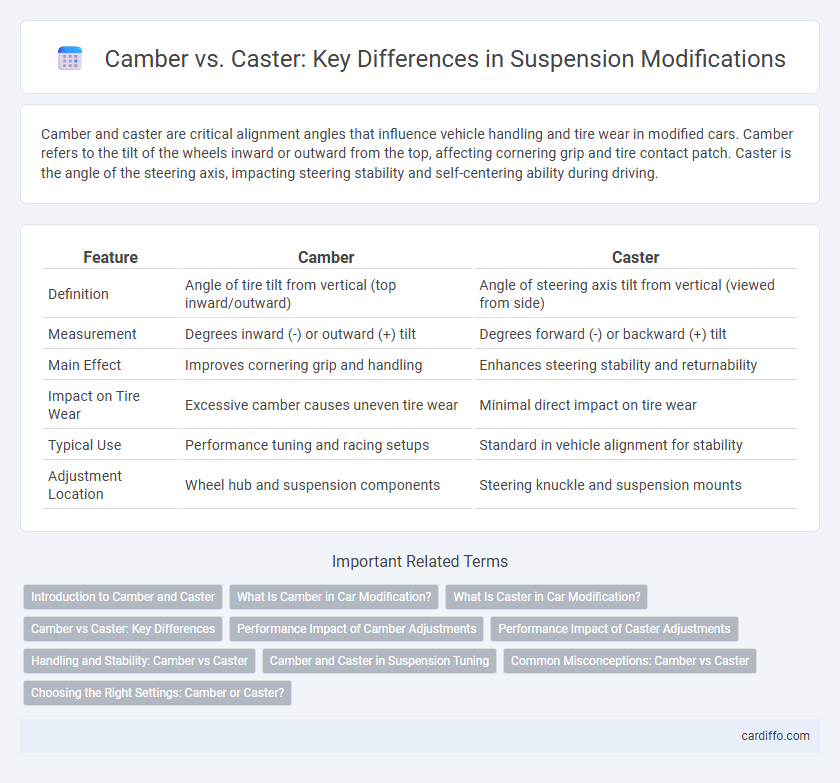Camber and caster are critical alignment angles that influence vehicle handling and tire wear in modified cars. Camber refers to the tilt of the wheels inward or outward from the top, affecting cornering grip and tire contact patch. Caster is the angle of the steering axis, impacting steering stability and self-centering ability during driving.
Table of Comparison
| Feature | Camber | Caster |
|---|---|---|
| Definition | Angle of tire tilt from vertical (top inward/outward) | Angle of steering axis tilt from vertical (viewed from side) |
| Measurement | Degrees inward (-) or outward (+) tilt | Degrees forward (-) or backward (+) tilt |
| Main Effect | Improves cornering grip and handling | Enhances steering stability and returnability |
| Impact on Tire Wear | Excessive camber causes uneven tire wear | Minimal direct impact on tire wear |
| Typical Use | Performance tuning and racing setups | Standard in vehicle alignment for stability |
| Adjustment Location | Wheel hub and suspension components | Steering knuckle and suspension mounts |
Introduction to Camber and Caster
Camber refers to the angle of the wheels in relation to the vertical axis when viewed from the front or rear of the vehicle, influencing tire contact and handling during cornering. Caster is the angle of the steering axis tilted forward or backward, affecting steering stability and returnability. Understanding camber and caster adjustments is crucial for optimizing vehicle alignment, improving grip, and enhancing overall driving performance.
What Is Camber in Car Modification?
Camber in car modification refers to the angle of the wheels relative to the vertical axis when viewed from the front or rear of the vehicle. Adjusting camber affects tire grip, handling, and wear by altering the contact patch with the road during cornering. Negative camber improves cornering performance by increasing lateral grip, while positive camber can enhance stability in straight-line driving.
What Is Caster in Car Modification?
Caster in car modification refers to the angle of the steering axis when viewed from the side of the vehicle, crucial for stability and steering feel. Positive caster angles improve straight-line stability and help the steering wheel return to center after a turn, enhancing control during high-speed driving. Adjusting caster degrees can significantly impact handling dynamics, making it a key factor in suspension tuning and overall vehicle performance.
Camber vs Caster: Key Differences
Camber and caster are critical alignment angles affecting vehicle handling and tire wear. Camber refers to the vertical tilt of the wheels, measured in degrees inward or outward, influencing cornering grip and tire contact patch. Caster denotes the forward or backward tilt of the steering axis, impacting steering stability and returnability, with positive caster enhancing straight-line tracking and steering feel.
Performance Impact of Camber Adjustments
Adjusting camber angles significantly affects tire contact patch and cornering grip, enhancing vehicle handling during aggressive turns. Increased negative camber improves lateral traction by maximizing the tire's contact area under compression, ideal for performance driving and track conditions. Excessive camber, however, can accelerate uneven tire wear and reduce straight-line stability, requiring balanced tuning aligned with specific driving demands.
Performance Impact of Caster Adjustments
Adjusting caster angles directly impacts vehicle stability and steering responsiveness, with increased positive caster enhancing straight-line tracking and cornering precision. Performance improvements include better high-speed stability and reduced steering effort, crucial for both road and track driving. Optimal caster settings help maintain tire contact patches, improving grip and overall handling performance.
Handling and Stability: Camber vs Caster
Camber affects vehicle handling by improving cornering grip through tire contact patch optimization, while caster influences steering stability and self-centering behavior. Positive camber enhances cornering performance but may reduce straight-line stability, whereas positive caster increases directional control and feedback at high speeds. Balancing camber and caster angles is crucial for optimal handling dynamics and overall vehicle stability.
Camber and Caster in Suspension Tuning
Camber adjustment in suspension tuning directly affects tire contact patch and cornering grip by tilting the wheels inward or outward, optimizing handling performance during turns. Caster modification influences steering stability and self-centering by altering the angle of the steering axis, improving high-speed control and feedback. Precise calibration of camber and caster angles enhances overall vehicle dynamics, balancing responsiveness with stability for improved suspension performance.
Common Misconceptions: Camber vs Caster
Camber and caster are often confused, but camber refers to the tilt of the wheels inward or outward from the vertical axis, impacting tire wear and cornering grip, while caster describes the angle of the steering pivot from the side view, influencing steering stability and returnability. A common misconception is that adjusting camber also affects steering feel, whereas camber mainly alters tire contact patch and handling balance. Properly distinguishing camber settings from caster adjustments is crucial for achieving optimal vehicle alignment and performance.
Choosing the Right Settings: Camber or Caster?
Selecting the right suspension settings depends on the driving conditions and goals, with camber affecting tire contact and grip during cornering, while caster influences straight-line stability and steering feel. Performance-focused setups often use negative camber to maximize cornering traction, whereas positive caster angles improve high-speed stability and steering returnability. Balancing camber and caster settings ensures optimal handling, tire wear, and overall vehicle dynamics for the intended application.
camber vs caster Infographic

 cardiffo.com
cardiffo.com